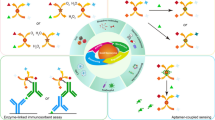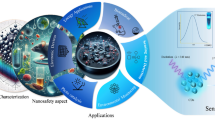A fluorescent nanosensor based on colloidal quantum dots CdSe/ZnS modified with mercaptoacetic acid to determine reduced glutathione, a non-protein compound that plays an important role in protection against oxidative stress, is developed. Sample preparation protocols that allow determination of reduced glutathione in a wide range of concentrations are presented. Dependence of the fluorescence intensity of the system on the incubation time for a number of concentrations of reduced glutathione was measured. The possibility of using the proposed nanosensor for reliable and sensitive determination of reduced glutathione in the concentration range from 10 to 1000 μM is confirmed. The results can be used for quantitative determination of reduced glutathione in physiological media, which is of considerable interest for medical diagnostics.





Similar content being viewed by others
References
L. Syedmoradi, M. Daneshpour, M. lvandipour, et al., “Point of care testing: The impact of nanotechnology,” Biosens. Bioelectr., 87, 373–387 (2017), DOI: https://doi.org/10.1016/j.bios.2016.08.084.
N. Hildebrandt, C. M. Spillmann, W. R. Algar, et al., “Energy transfer with semiconductor quantum dot bioconjugates: a versatile platform for biosensing, energy harvesting, and other developing applications,” Chem. Rev., 117, No. 2, 536–711 (2017), DOI: https://doi.org/10.1021/acs.chemrev.6b00030.
L. I. Kolesnikova, O. A. Vanteeva, N. A. Kurashova, and B. Ya. Vlasov, “Glutathione as an important component of the thiol disulfide system in the pathogenesis of infertility in overweight men,” Vestn. Ros. Akad. Med., 68, No. 7 (2013), DOI: https://doi.org/10.15690/vramn.v68i7.705.
D. M. Townsend, K. D. Tew, and H. Tapiero, “The importance of glutathione in human disease,” Biomed. Pharmacother., 57, No. 3–4, 145–155 (2003), DOI: https://doi.org/10.1021/ja0203925.
L. Flohe, Glutathione (oxidative stress and disease), CRC Press, N.Y (2018).
E. V. Dorozhko and E. I. Korotkova, “Study of antioxidant properties of biologically active sulfur-containing compounds by voltammetric and spectrophotometric methods,” Khim. Farm. Zh., 44, No. 10, 53–56 (2010), DOI: https://doi.org/10.30906/0023-1134-2010-44-10-53-56.
Y. Li, P. Wu, H. Xu, et al., “Anti-aggregation of gold nanoparticle-based colorimetric sensor for glutathione with excellent selectivity and sensitivity,” Analyst, 136, No. 1, 196–200 (2011), DOI: https://doi.org/10.1039/c0an00452a.
Zhang N., Qu F., Luo H Q. , and Li N. B., “Sensitive and selective detection of biothiols based on target-induced agglomeration of silvernanoclusters,” Biosens. Bioelectr., 42, 214–218 (2013), DOI: /https://doi.org/10.1016/j.bios.2012.10.090.
R. Deng, X. Xie, M. Vendrell, et al., “Intracellular glutathione detection using MnO2-nanosheetmodified upconversion nanoparticles,” J. Am. Chem. Soc., 133, No. 50, 20168–20171 (2011), DOI: https://doi.org/10.1021/ja2100774.
Mi Y., Lei X., Han H., et al., “A sensitive label-free FRET probe for glutathione based on CdSe/ZnS quantum dots and MnO2 nanosheets,” Analyt. Methods, 10, No. 34, 4170–4177 (2018), DOI: https://doi.org/10.1039/C8AY01532E.
J Pan, Z. Zheng, J. Yang, et al., “A novel and sensitive fluorescence sensor for glutathione detection by controlling the surface passivation degree of carbon quantum dots,” Talanta, 166, 1–7 (2017), DOI: 0.1016/j.talanta.2017.01.033.
J. Liu, C. Bao, X. Zhong, et al., “Highly selective detection of glutathione using a quantum-dot-based OFF–ON fluorescent probe,” Chem. Commun., 46, No. 17, 2971–2973 (2010), DOI: https://doi.org/10.1039/B924299F.
Author information
Authors and Affiliations
Corresponding author
Additional information
Translated from Izmeritel’naya Tekhnika, No. 9, pp. 16–21, September, 2019
Rights and permissions
About this article
Cite this article
Alenichev, M.K., Yushina, A.A., Drozhennikova, E.B. et al. Fluorescent Nanosensors Based on Colloidal Quantum Dots for the Determination of Reduced Glutathione. Meas Tech 62, 784–789 (2019). https://doi.org/10.1007/s11018-019-01695-x
Received:
Published:
Issue Date:
DOI: https://doi.org/10.1007/s11018-019-01695-x




